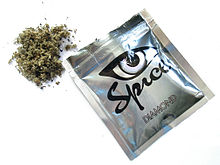Georgia and other states are seeing a rise in poison center calls that are linked to use of synthetic marijuana.
The CDC reported last week that between January and May, poison centers in 48 states reported receiving 3,572 calls related to the use of what scientists call synthetic cannabinoids.
That’s a 229 percent increase from the 1,085 calls received during the same period in 2014. The national figures include 15 reported deaths.
Hundreds of synthetic marijuana cases have occurred this year in Mississippi, Gaylord Lopez, director of the Georgia Poison Center, said Monday.
The Georgia center said it received 30 calls on synthetic cannabinoids during the first five months of this year, up from 16 in the same period during the previous two years.
These synthetic substances include various psychoactive chemicals or a mixture of such chemicals that are sprayed onto plant material, which is then smoked or ingested.
These products are known by a variety of names, including synthetic marijuana, spice, K2, black mamba, and Crazy Clown, and can be sold in retail outlets as herbal or natural products. They are marketed as safe, but the CDC report said they “pose an emerging public health threat.”
The most commonly reported adverse health effects associated with synthetic cannabinoid use are agitation, tachycardia (increased heart rate), drowsiness or lethargy, vomiting and confusion, the CDC reported.
“It is something to be concerned about,’’ Lopez said. He added that almost all the synthetic marijuana calls to the poison center came from hospital ERs in Georgia.
“There’s no requirement that Georgia hospitals call those in,” he noted.
Dr. Brenda Fitzgerald, commissioner of the state Department of Public Health, wrote a letter to Georgia doctors and physician assistants in April to warn them about a surge in synthetic marijuana in other Southeastern states.
She cited an increase in synthetic marijuana-related visits to hospital emergency rooms in Alabama, Mississippi and Louisiana.
“Each of these states has recently recorded nearly 500 ED [emergency department] visits related to ‘Spice,’ resulting in more than 100 hospitalizations and at least four deaths,” Fitzgerald wrote.
“There is no control of the types or amount of chemicals it contains, so users have no way of knowing what they are ingesting,’’ she added.
“I urge you to consider synthetic marijuana use with individuals presenting with symptoms that are otherwise unexplainable or unusual.”
Memories of 2013
Such substances created a scare in coastal Georgia two years ago.
In 2013, the Brunswick area saw more than 20 people sickened from a drug believed to be a synthetic cannabinoid. Brunswick drug raids resulted in the arrests of four people on charges related to the sale of suspected synthetic marijuana.
The Georgia Drugs and Narcotics Agency told GHN at the time that the main synthetic drug in Brunswick, Crazy Clown, was classified as a Schedule I controlled substance covered under “Chase’s Law.’’ The law is named after Chase Corbitt Burnett, a 16-year-old honor student from Fayette County who died shortly after experimenting with synthetic pot.
Chase’s law, passed by the Georgia General Assembly in 2012, was intended to ban all forms of synthetic marijuana. The law lists ingredients used to make synthetic marijuana as Schedule I drugs, which means that even possessing any of these substances is a felony.
But it’s hard to keep up with every chemical that might potentially go into synthetic pot. Fitzgerald’s letter noted that the manufacturers “attempt to evade legal restrictions by substituting different chemicals in their mixtures.”
“As a result,” her letter continued, “the composition of synthetic marijuana is not known, and can change frequently, so clinicians are advised to treat patients symptomatically as there is no specific treatment.”
The CDC report urged greater public health monitoring and awareness, targeted public health messaging, and enhanced efforts to remove the products from the market.
Lopez said the chemists making synthetic marijuana “are way ahead of us in terms of the legal system.”
“They’ve got two main goals – stuffing their pockets with money and trying to improve the user experience,’’ he said. “They’re actively using buyers as guinea pigs.’’
Dr. Patrick O’Neal, director of health protection at Public Health, added that symptoms of synthetic marijuana use can vary greatly, “leading to what may be an under-reporting of actual poisonings.”
“There are increasing reports of fentanyl being mixed with synthetic marijuana, leading to death in many individuals,” O’Neal said. “When people purchase and use these synthetic cannabinoids, they have no idea what’s in them, and they are taking tremendous risk.”



